New 2013 Introductions
Primarily from our own wild seed collections divided into 3 sections:
New cultivar names we are allocating or introducing
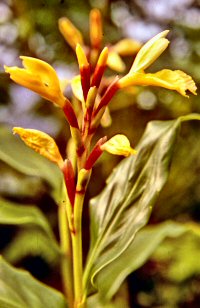 |
Cautleya gracilis 'Crûg Gold' BSWJ7186
Is a cultivar name that we are applying to a clone that we collected from the forested area close to the summit of Doi Phohon-Pok. A mountain within The Golden Triangle straddling the border between Burma and Thailand. Forming clumps of vertical slender green stems, to 80cm tall, with oblong-lanceolate leaves. Bearing July-October terminal spikes of up to 10 yellow long lipped flowers on red stained stems protruding from deep red calyces.
|
|
|
|
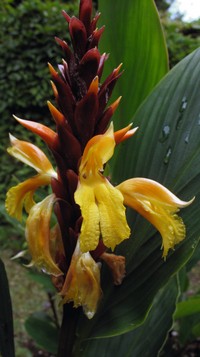
|
Cautleya spicata 'Bleddyn's Beacon' BSWJ2408 Is a cultivar name that we are applying to a robust clone we collected on the Yoksum trail western Sikkim in 1994. Originally sold with only its collection number, but soon selling out as this clone was not vigorous enough to keep up with demand. Meaning the plant's energy is concentrated on flowering. Of a stocky nature with strong dark red stems (hence old species name of C. robustum, not the cultivar) bearing longer than normal terminal inflorescences of dark red overlapping bracts with sizeable protruding yellow flowers over a long period June to October.
|
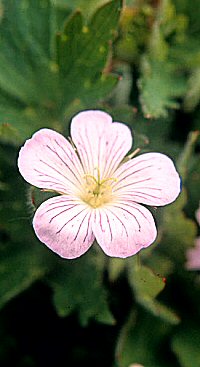 |
Geranium shikokianum v. quelpaertense 'Crûg’s Cloak' BSWJ1234
A very rare and distinct variety of the species, which we collected after a long climb in the snow. Growing in the summit area of Hallasan the highest peak in South Korea on the island of Chejudõ, the only known site it inhabits, in the autumn of 1993. For us it forms a low growing carpet, from a central fleshy rootstock with radiating sprawling stems densely covered with softly bristly palmate leaves. Forming a perfect foil for the pale pink dark veined flowers carries from mid summer until frost. This clone has only been propagated from division, as it hybridises readily.
|
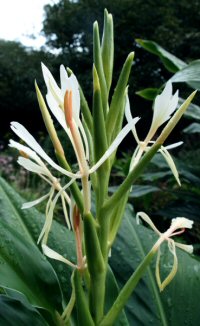
|
Hedychium 'Helen Dillon'
Is the name we are proposing to cover a superb hybrid (I suspect) which masquerades as H. forrestii and/or H. forrestii hort., in cultivation. The situation as it is, is unsatisfactory particularly to someone such as ourselves who are very familiar with the true species. Which has to be said will be unlikely to ever make a decent garden plant in the UK, due to its late flowering. In contrast the plant in question is one of the best hardy gingers for our gardens, flowering well even further north than ourselves. Forming tall stems to around 1.5-2m, just about robust enough to stand upright, with dark green paddle-shaped leaves. Flowering August to October here, bearing almost pure white heavily scented flowers, with up to three flowers arising from each rolled bract in succession. Meanwhile the anthers are a fleshy yellow colour (white in H. forrestii). It is known to bear seed in the UK. We are taking the opportunity to name this clone for our dear friend Helen Dillon, from the fair city of Dublin, who gifted us a plant some years ago, as she so generously has to so many gardeners.
|
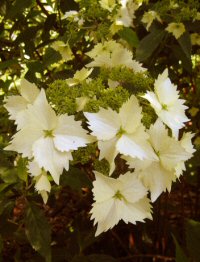 |
Hydrangea chinensis 'Golden Crane' DJHC0499
Has been named by Dan Hinkley, covering a collection he made in China, Sichuan I presume. It is a form of the species with exceptionally large conspicuously serrated sterile white flowers, whereas the fertile flowers age a golden yellow, hence the name.
|
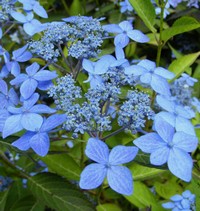 |
Hydrangea serrata 'Crûg Sõ Cool' BSWJ6241b
One of four selected seedlings originating from one of our seed collections gathered from the Mt. Unzen area of Kyushu, Japan in 1998. Of a very floriferous small form of this amenable deciduous lacecap species hydrangea, bearing corymbs of strong blue lace-cap (pink in acid soil) flowers May-October. The sterile florets deepening in colour with age, availing us with a cool blue effect. While the foliage ages to a purple cast if exposed to sun, as in the field where we grow the mother plants, which are still only 1.3m (just over 4ft) tall without pruning at around 12 years old.
|
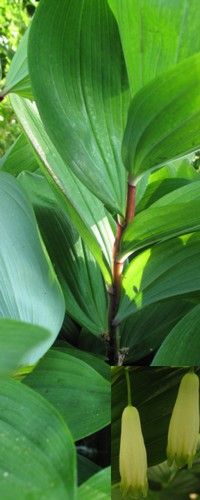
|
Polygonatum odoratum 'Flatmate' BSWJ857
Originating from one of our 1993 collections gathered from coastal pine forested (at that time) sand dunes of the Mallipo Peninsular, on the west cost of South Korea. An upright form to around 80cm tall with green stems, reddening with exposure to sunlight. The stems being very distinctly flattened like the cross section of a propeller, translucent towards their edges. While the leaves are on the large side to 15cm long on the largest, oblong to ovate glaucous white below, the base of the leaf clasping half the stem, the petioles indistinct. The flowers are the normal fragrant white green tipped as seen on this species.
|
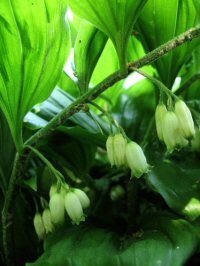 |
P. hirtum 'Robustum'
Is a robust form of this species with hirsute arching ribbed stems capable of forming stems to 1.2m long in good conditions. Bearing alternate elliptic-ovate to orbicular ribbed leaves noticeably glossy above, on clasping petioles with axillary racemes of up to 4 pendant tubular white green-lobed flowers late April-May.
|
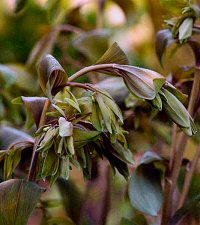 |
P. multiflorum 'Ramosissima'
Is a strong growing form of this European species, that the long slender tubular flowers with recurving lobes are normally borne in slender few flowered pendant racemes. By contrast in this named form they produce stronger plants with strongly arching stems to 1m long of alternate leaves bearing from their axils, strong multi flowered racemes of flowers on mature plants sometimes leafy, during May and June.
|
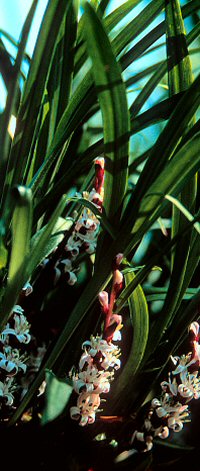 |
Reineckea aff. carnea 'Crûg's Linearleaf' BWJ8029
Originating from one of my plant collections gathered from Longzhoushan Sichuan with Dan Hinkley in 2000. Of a very distinct form (some including myself believe there are more than one species) of this evergreen woodland perennial closely related to lily of the valley. The form we are allocating this cultivar name arises from long to very long underground slender rhizomes, to tufts of linear grass-like dark green leaves more reminiscent of Ophiopogon or Liriope. Forming a dense carpet of upright dark foliage to around 20cm tall. Bearing palest pink lily of the valley-like flowers on contrasting reddish stems August-October
|
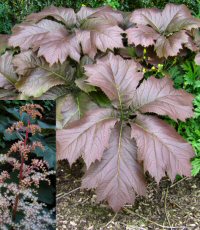 |
Rodgersia podophylla 'Crûg Colossus' BSWJ10909
This clone originates from a small plant we collected as we were leaving the rich forests of Aomori in the north of Honshu in 2005. Primarily selected for its dramatic size, which is not that uncommon in that area, of at least 1m across, the leaf composed of five leaflets. On growing this plant on in our small shaded stock field we soon realised the foliage was also blessed with a colourful flush of reds throughout its growing time of the year. Arising as red even pinkish shoots through all shades of red to bronze over the season. Even the inflorescences are flushed pink with us.
|
|
|
|
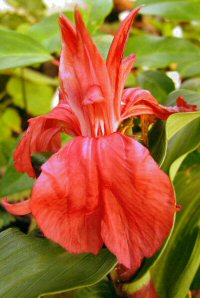 |
Roscoea purpurea f. rubra 'Gurkha Redstem'
Is a cultivar name we are applying to plants that we have obtained from cultivation as ‘Red Gurkha’ with red-brown stems, that we have increased by division. As the name ‘Red Gurkha’ applies to both red and green stemmed plants of this form, we thought it appropriate to allocate a name to this form with red-brown stems.
|